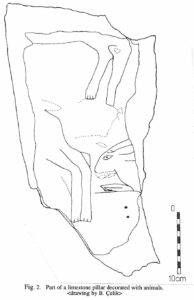A New Early-Neolithic Settlement: Karahan Tepe
Karahan Tepe lies some 63 km east of Sanliurfa (Urfa), southeastern Turkey in an area called Tektek Daglan (Tektek Mountains). Some 266 in situ pillars were observed in the fields on the northern and eastern slopes of the hill. Since this area, which was discovered by the author in 1997, was not named on the maps, it was thought to be suitable to name the site “Karahan Tepe” after a hill nearby (Footnote 1) Geomorphologically, the Tektek Mountain area in the vicinity of the Karahan Tepe settlement in the southeast part of Harran plain is more of a range of high hills rather than mountains (Giizel n.d.: 170-171). It is a dissected Eocene and Miocene limestone formation whose valleys which were formed by erosion during interglacial and post-glacial periods under humid climatic conditions (Atalay 1994: 280-282). There is no basalt in Tektek Daglari; the nearest basalt source is 15 km to the north of the settlement. Flint probably was obtained from the nodules found in the limestone of the area. The region has an average altitude of between 600 in and 800 m. It is a rural area where people today are involved primarily in animal husbandry and some agriculture. This poorly watered area was also settled in Antique Age (Sinclair 1990: 183-184). It is still observed in the autumn that nomadic families come down from Karacadag Mountain in northern $anliurfa to stay in the Tektek Mountain area during winter and graze their animals on the pasture. The vicinity is also very rich in wild game and is a locally popular hunting area even today. Except towards the NW end, where pistachio trees (Pistacia khinjuk) are present, there is no woodland on Tektek Daglan…..



